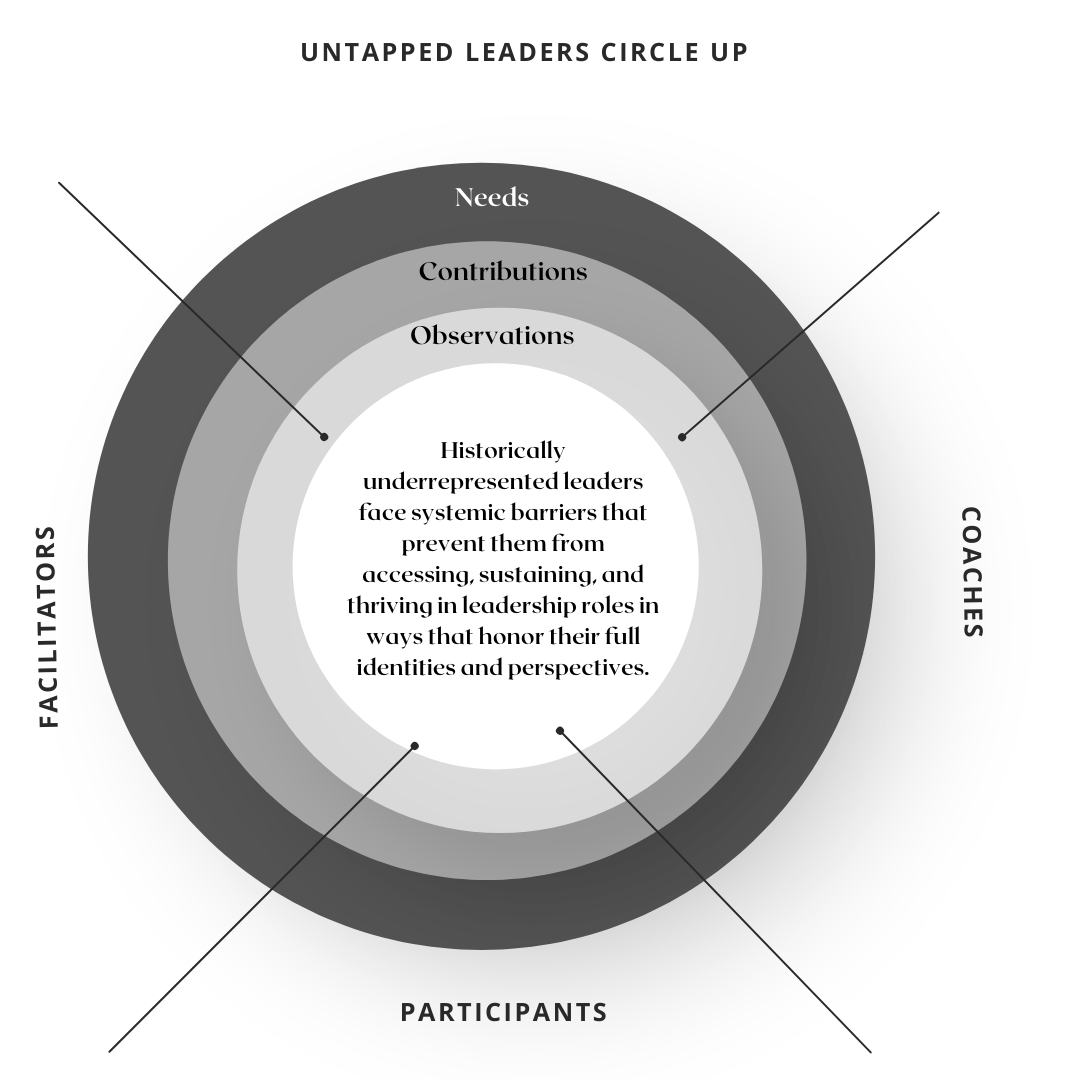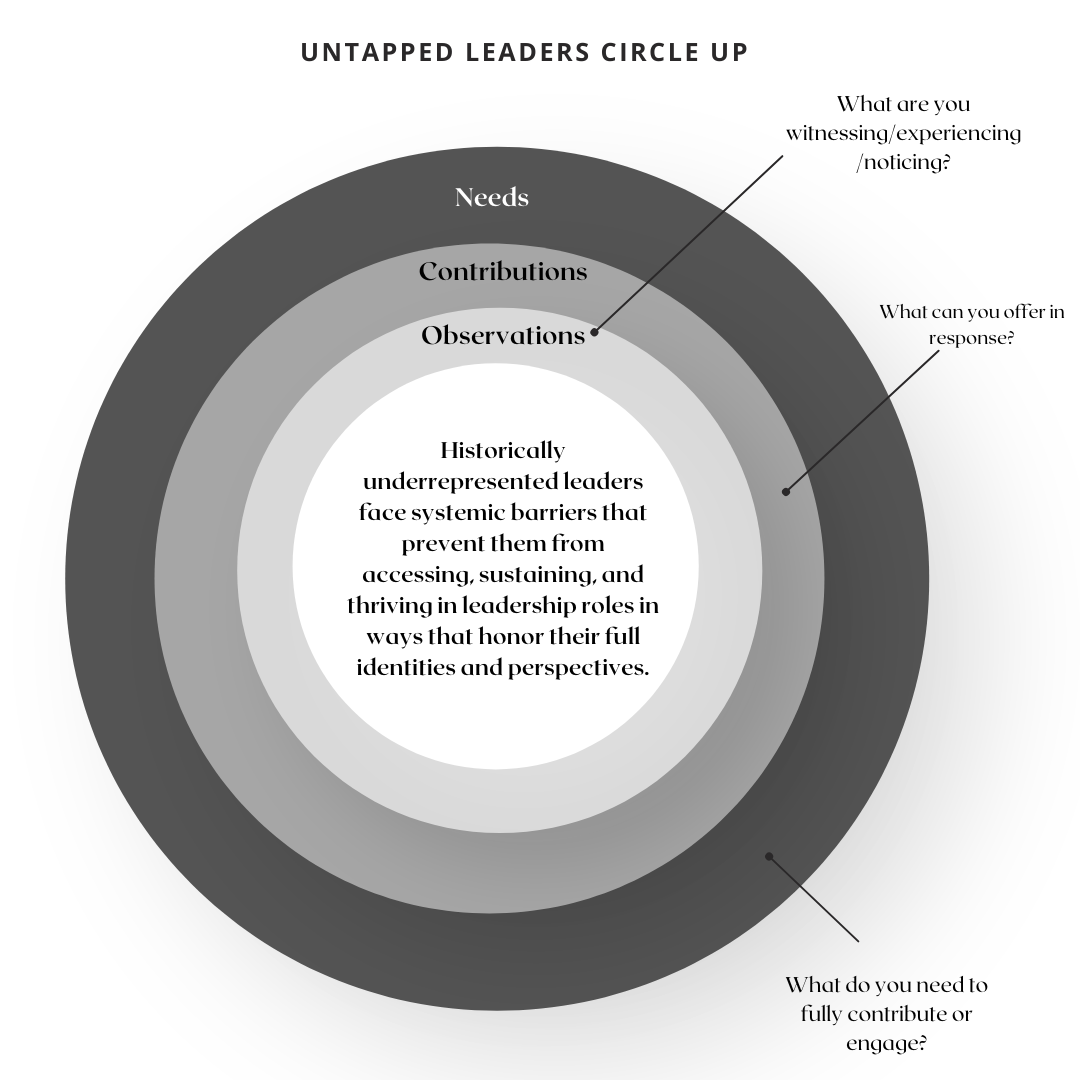From Hierarchies to Circle-Ups: A Framework for Collective Insight
I just started experimenting with a structure I call the Circle-Up framework, and it’s been helping me and the Untapped Leaders community navigate complex organizational questions and challenges, as a collective of mission-driven leaders working to reimagine what inclusive leadership can look like.
For years, I’ve facilitated rooms where the same pattern played out: someone at the top speaks first, and everyone else orients around that.
Insight gets flattened.
Nuance gets lost.
People disengage, or comply, or wait for the “right” moment to speak, which may never come.
So I created something different. Circle-Up is an intentional and vision-driven way to lead with, not over. It’s not a product. It’s not proprietary. It’s a practice that invites us to step out of hierarchy and into shared inquiry.
Why We Needed a New Way to Gather
In most organizational charts, leadership is visualized as a triangle—pointed, stacked, and narrow at the top.
Most of us are taught to default to hierarchy when making decisions, leaning on the most senior voice, the fastest opinion, or the loudest urgency. But that approach often misses the mark in times of disruption or transition. It excludes the very insights we need to move forward wisely: the lived experiences, challenges, and ideas of people closest to the work.
What if leadership looked more like a circle?
A circle has no top or bottom. It centers something—a mission, a question, a community—and invites everyone around it to see it from their vantage point. That doesn’t mean chaos. It means coherence. It means designing for wisdom, not just direction.
Example Circle Up from an Untapped Leaders session in response to the current political and corporate climate.
The Circle-Up Framework, Explained
At its core, the Circle-Up is a participatory framework to bring together people from across roles or sectors to explore a challenge or opportunity.
Here’s how it works:
We name what we’re noticing. Patterns. Possibilities. Shifts. What are we noticing in our work or world? What’s challenging us? What feels like it’s shifting?
We name what we can offer. Ideas. Resources. Presence. What expertise or resources can we offer in response? What are we willing to invest—time, energy, funds, presence?
We name what we need. Support. Clarity. Trust. What do we need in order to show up fully, sustainably, and meaningfully in this work?
Each round prompts participants to speak from their experience, not to debate or fix. By the end, we don’t necessarily have a decision. We have clarity, resonance, and a map of where energy and possibility live.
Tool tip: The Circle-Up works best when:
You have a big question, not a pre-set agenda.
You invite people with diverse stakes in the issue.
You hold the center, not the top. (The core challenge or mission goes in the middle—everything else radiates from that.)
High-level prompts to structure the discussion and provide participants with guidance of how to focus contributions.
Born in Complexity, Built for Possibility
I didn’t invent this framework in a vacuum. It emerged from working with leaders across systems—education, philanthropy, tech, government—where the problems were too complex for one person to “fix.” Where performance culture created performative listening. Where real leadership had to be practiced, not performed.
I saw again and again how the most impactful leaders were the ones who:
Knew when to pause instead of push
Created space rather than filling it
Centered insight over control
These leaders weren’t trying to be the smartest person in the room. They were trying to make the room smarter.
This isn’t a tool for the “move fast and break things” crowd. It’s for leaders ready to move thoughtfully and build together.
What This Represents
The Circle-Up isn’t just a meeting format. It’s a worldview, a mindset, a refusal to believe that the best ideas come from above or that leadership always looks like certainty, control, or charisma.
It’s part of a bigger vision I’m holding:
A leadership model built not on dominance, but on depth.
Not on power-over, but on power-with.
Not on hierarchy, but on huddle.
Because the truth is: the future isn’t asking us to be louder. It’s asking us to listen better.
And circles are good at that.
An Invitation
If your organization is trying to figure out how to bring more voices into the room without losing focus, try a Circle-Up. Start small. Frame a question. Invite folks in. Let the wisdom emerge.
And if you’d like a PDF walk-through of how we structure this at Untapped Leaders, drop me a note. I’m happy to share.
If you’d like support implementing a Circle Up process, through facilitation or consultation, schedule a call.

